Windows 10 Start menu secrets every desktop pro should know
我们深入挖掘Windows的技术预览版的开始菜单进行微调,这样你就不必

Windows 10 Start menu secrets every desktop pro should know
Windows 10 promises to bring back the Windows 7 Start menu for those of us who still slavishly utilize a keyboard and mouse -- you know, the people whotry to get "real work" done with Windows。
Windows Technical Preview build 9860 shows a Start menu that's familiar on the left and Metro-esque on the right. While Microsoft is likely to change the Start menu substantially before the final version of Windows 10 ships in the second half of 2015, the plumbing's in and working, and it holds a lot of new possibilities.
Here's a guided tour the Win10 Start menu and how to make the most of it. It’s light on the easy stuff -- pinning, resizing, and so on -- and heavy on the deeper fare you probably haven't seen yet.
I also point out some of the obvious Start menu shortcomings and bugs as we step through the details. If you encounter other bugs, report them to Microsoft via the Windows Feedback app -- which you’ll find in the Windows Start menu, of all places!
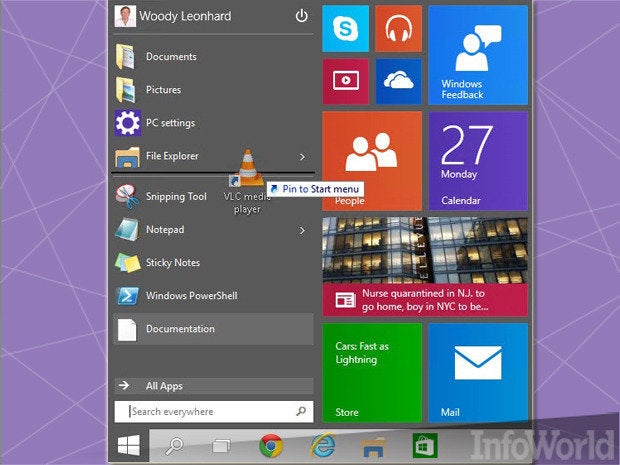
Basic actions on the left side
如果你与所有的Win10开始菜单中出场,你可能知道你可以拖放项目的固定部分,在左侧的顶部。你可以在下部不拖拉物品,虽然。与Windows 7,那下面的列表应该是您最常使用的程序,虽然也喜欢在Win7中,Windows操纵名单,有利于在其他一些程序。
您可以从顶部或左边的底部删除项目:右键单击,选择“从列表中删除。”
If you right-click on an item on the left side and choose Pin to Start, Windows creates a new tile and sticks it on the Metro-tiled right side of the Start menu. Usually you can drag the item from the left side to the right and accomplish the same thing.
The only way I've found to add items to the top of the left side is to drag and drop them. It's easy to drag from Explorer, the desktop, the right Metro side of the Start menu, or nearly anywhere else. In Win7, you could Pin to Start, and the chosen entry would end up in the top list. Not so in Win10: Pin to Start means "Make a tile and Pin it to the Metro tile list."
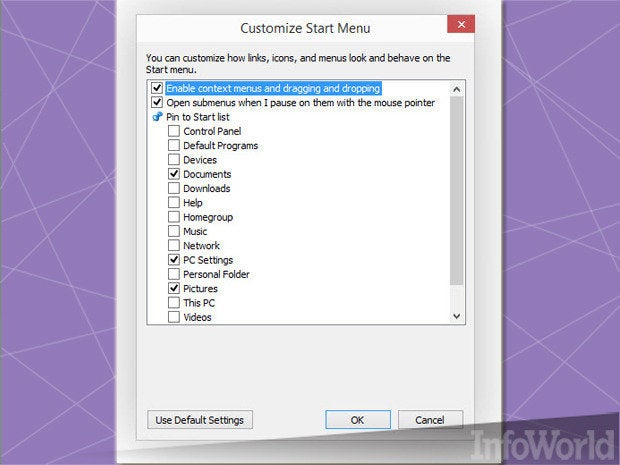
Independent control over the top of the Start menu
虽然您可以拖放物品的the left side of the Start menu, you can also independently tell Windows what you'd like to see up there. To do so, right-click on any empty part of the taskbar, choose Properties, pick the Start Menu tab, and click Customize at the bottom.
There you'll see listed the items that, if checked, will always appear at the top of the Start menu. If you accidentally right-clicked and unpinned an item from the Start menu list, this is where you go to get it back. If you lament the passing of Control Panel, Music, Network, or the others, you can bring them back to the top of the Start menu with a couple of clicks.
The Start Menu tab of the Taskbar Properties dialog is also where you go if you want to kill the Start menu entirely and revert to the Windows 8-style Metro Start screen. I think of that as the Windows 10 equivalent of going feral.

Get rid of apps on the All Apps pane
当您在所有应用点击开始菜单左侧的底部,你会被显示在一个大的,按字母顺序列出地铁应用程序(也可能是桌面程序)的数量庞大不堪重负,与文件夹名称底部和顶部的所有其他项目。
If you find any third-party Metro apps (that is, Metro apps not originating from Microsoft) on the list, it's easy to uninstall them and thus take them off the All Apps list. To do so, right-click on the All Apps item and choose Uninstall. Windows will terminate with extreme prejudice, as shown in the screenshot.
While it's possible -- even easy -- to eliminate built-in Metro programs with a right-click and Uninstall, I'd avoid doing that, at least for "important" Metro apps. You can shoot Sound Recorder that way and nobody will know the difference, but it isn't advisable to uninstall, say, Store or Windows Feedback. If you accidentally uninstall a built-in Metro app that you later discover you need, the only recourse I know at this point is to perform a System Refresh (Start, PC Settings, Update and Recovery, Recovery, Refresh).
您可能会发现在所有应用列表中的某些环节没有右键点击卸载选项。如果你想摆脱那些之一,看该文件夹中的C:Usersor in the folderC:ProgramDataMicrosoftWindowsStart MenuPrograms。快捷方式有(比文档和图片,这似乎为每个用户除外)可以不受惩罚地删除:删除快捷方式,以及相关的条目从所有应用中消失。

Custom folders on the All Apps list -- not yet working correctly
Microsoft has yet to bring full Windows 7-level support to customizing the All Apps list, but most of the meat is there and operational.
在他所示的屏幕截图re, I created a folder calledAskWoodyinC:ProgramDataMicrosoftWindowsStart MenuPrograms,并把四个文件夹内AskWoodyfolder. (...开始MenuPrograms在Windows 7中使用的所有用户增加的所有程序列表中的位置),那么我注销并重新登录。你可以看到,该文件夹结构复制忠实地在Windows 10的所有应用程序列表,因为任何的Win7大师所期望的。
The same procedure works withC:Users, which is the Win7 "this user only" location.
Programs, shortcuts to programs, and shortcuts to folders placed inside the homegrown folders appear on the All Apps list, and they function exactly as they do in Win7.
不幸的是,放置在自产自销的文件夹中的文件没有出现在Win10所有应用列表 - 至少,不是在构建9860.文件中该位置出现在Win7的所有程序列表。我的猜测是,我们将看到在以后的版本恢复功能。
For those of you who have asked, I tried and tried but couldn't figure out how to stuff all of those Metro app icons into different folders. (Ping me in the comments if you've figured it out!) Microsoft will certainly give us tools to manage all of those All Apps entries by the time Win10 ships, I assume.
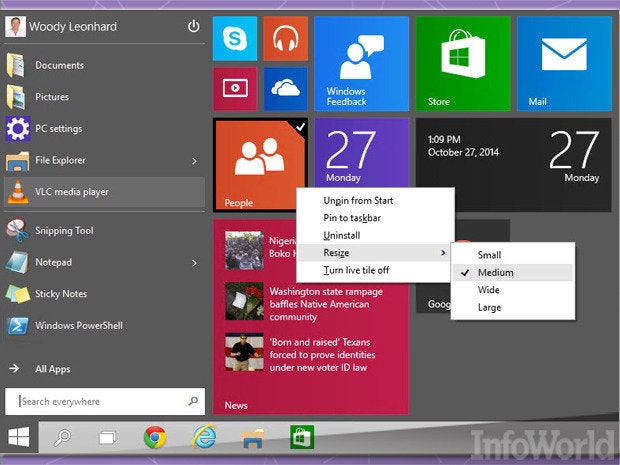
Basic actions on the right side
在许多方面,地铁瓷砖上的开始菜单右侧的行为很像他们的地铁启动画面我们都来爱和敬佩在Windows 8和8.1同行。您可以拖动他们身边,他们会碰到其他的瓷砖在一个相当严格的形成排队:小青瓦去旁边给对方,新列会自动显示出来,你不能创建自己的新列,除非其他列充分。任何 - 但不是全部 - 瓷砖的大小可以调整,四个尺寸之一。(截屏显示四小,六中,一个宽和一个大tile)。
Some of the apps change what's displayed on the tile, and if that activity bothers you, then you can right-click and choose “Turn live tile off.”
Don't want to see any tiles? Easy: Right-click on each, one at a time, and choose Unpin from Start. Right-click and choose Uninstall, and the app is uninstalled. Want to pin an app that appears in the Metro tile portion of the Start menu to the left side of the Start menu? No sweat: Drag it from right to left.
您可以拖动从开始菜单到桌面的右侧地铁瓷砖和创建一个快捷方式。快捷方式是像任何其他快捷方式;右键单击并选择属性来更改名称或图标 - 默认的图标看起来像鬼的幻象,如果你能在所有看到它们。这不是表现得镇定的Win7小工具,但我们一定能成功。
To date we haven't seen any intelligent tiles -- ones with interactive controls on the face, like a Play button on the Audio tile -- but many people figure that will come when the Win10 consumer beta version hits early next year.

Make the Start menu taller or shorter
You can drag the top bar on the Start menu and make the entire menu taller or shorter, within the confines of your screen. But you can't adjust the size left to right. The Start menu gets wider and narrower to accommodate the tiles you've pinned in it. If you have too many tiles, they flop over to the right, and you can scroll to see them.

Make File Explorer open to This PC
Many of youhave complained我(和Microsoft),您不希望文件浏览器打开新的,虚构的首页。在Windows 7中,资源管理器打开库文件夹。在Win8中/ 8.1它打开这台电脑,这说明你的主文件夹(桌面,文档,下载,音乐,图片视频),驱动器和设备,以及网络位置。
这是如何创建的地铁瓷砖Win10 Start menu that opens to This PC and how to pin that tile to the desktop's taskbar. (I believe this trick is previously undocumented.)
1. In the Start menu's “Search everywhere” box, type这台电脑(note the space). This PC appears as the first item on the search results list.
2. Click and drag that This PC item to your desktop. You get a shortcut to This PC.
3.右键单击新图标,并选择固定到开始。这使右侧的瓷砖,在开始菜单的地铁边。
4. Left-click the new Metro tile and drag it to the taskbar.
You end up with a This PC Metro tile on the right side of the Start menu and a This PC icon on the taskbar.
You can use that new Metro tile, or the new icon in the taskbar, to open File Explorer at This PC. Removing it is as easy as right-clicking and choosing either Unpin from Start and/or Unpin this program from taskbar.

Make a shortcut to show your printers
这里的另一个调谐到同一个主题,使用旧的控制面板黑客。
Do you remember the Windows 7 Devices and Printers list? It's still around in Windows 10, but you have to dig for it. There's an easy way to stick a link to the Devices and Printers list on your desktop, and from there move it into the Start menu. Try this:
1. Right-click the Start button and choose Control Panel.
2. In the Hardware and Sound section, left-click the line marked View Devices and Printers and drag it onto your desktop.
3. Drop it on your desktop, and you have a new shortcut into the Devices and Printers list. Right-click on the icon and choose Pin to Start. It'll show up as a tile on the right (Metro) side of the Start menu.
4. From there you can click and drag the tile over to the left side of the Start menu, and/or right-click and choose Pin to Taskbar.
Many of the old Control Panel applets can be pinned in a similar fashion.

创建任何驱动器或文件夹中的开始菜单项
Generally, pinning a drive or folder to the left side of the Start menu is pretty easy. I say "generally" because I've hit situations with network drives where the general approach doesn't work.
Most of the time, you can left-click and drag the folder or drive to the Start icon, then place it on the Start menu.
If that doesn't work, navigate to the drive or folder, right-click on it, and choose Pin to Start. That puts a tile on the right side of the Start menu. Click and drag that tile to the top of the left side of the Start menu; the resulting pinned item will sweep you directly to the chosen drive or folder.
In either case, you can right-click on the tile or the Start menu item and choose "Pin to taskbar" if you'd like to see it down at the bottom.
If you ever want to remove the Start menu item, right-click on it and choose "Remove from this list."

Make File Explorer open to any location
There's another way to skin this cat -- an approach with additional options. Nothing like an old trick with a new twist. Windows shortcuts have the power to launch File Explorer and have it start off in the directory of your choice. Here's how:
1. Right-click any open spot on the desktop and choose New, Shortcut. You’ll get a properties dialog like the one in the screenshot.
2.在目标框中,键入Explorer.exe后面,告诉浏览器打开正确的方式,在合适的地方的开关。有一个在有效开关的完整列表微软的KB 152457。In this case, I want Explorer to start "rooted" at the locationC:UsersWoodyDocumentsInvoices。I type:explorer.exe /root,C:UsersWoodyDocumentsInvoices
Note there is no space to the right of the comma. (Use quotes around the folder name, if it has spaces.)
3.单击常规选项卡,并给快捷方式的名称。您还可以点击快捷方式选项卡上更改图标按钮并选择一个不同的图标。(科技共和国的一个很好的概述带图标文件。) When you're done, click OK.
4.单击该图标,将其拖动到开始按钮。当开始菜单展开,删除图标拖到开始菜单左侧的顶部。
5. If you want a Metro tile on the right side of the Start menu, drag the new Start menu item over to the right. If you want a taskbar icon to match, right-click the Start menu item and choose “Pin to taskbar.”
I believe that trick's previously undocumented in Windows 10, too.

Change the Start menu's background color
您可以更改开始菜单上的背景颜色,但在这样做时,您更改任务栏上的背景色和您的所有窗口的标题栏。自己试试:在开始菜单(两侧)的空白处单击鼠标右键,选择个性化。
默认情况下Windows适应的背景颜色,使其脱颖而出 - 这是默认设置,在左上角。您可以从提供的颜色选择或组合自己的,手动调节亮度,色调,饱和度和亮度的一个。
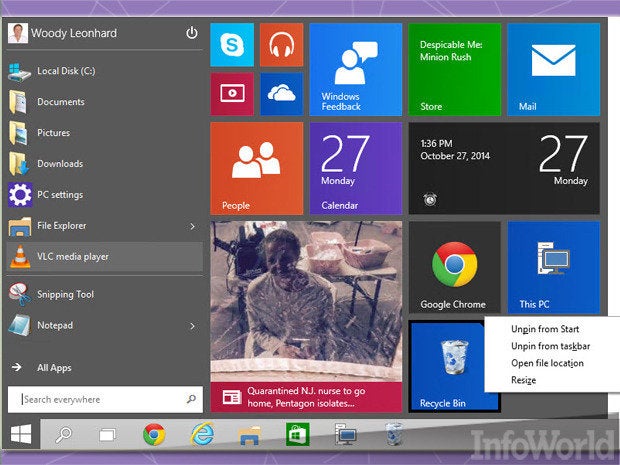
Pin the Recycle Bin to the Start menu and the taskbar
Probably more effort than it's worth, but you can (finally!) pin the Recycle Bin to the taskbar and/or the right (Metro) side of the Start menu. That way you can avoid digging all the way down to your desktop to empty the Recycle Bin. I figure I do that once every six months.
Right-click the Recycle Bin on the desktop and choose Pin to Start. Then in the Start menu, right-click on the new Recycle Bin tile on the right and choose “Pin to taskbar.”

Keyboard shortcuts for Start menu apps
Several people have complained that they can't set up keyboard shortcuts for their programs. In Windows 7, you could right-click on any entry in the Start menu, choose Properties, and assign a shortcut key to the program. Typing the shortcut would invoke the program.
In Win10, you have to be a little more devious. Here's how.
You have to keep track of your own shortcut keys. Win10 inherits Win7's inability to warn you about duplicated shortcut keys, and if you assign the same key combination to two different shortcuts, heaven only knows which one will respond first. Caveat emptor.
版权© 2014足球竞彩网下载


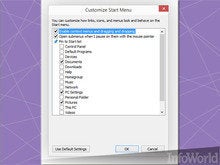














![Network World [slideshow] - Top 10 Supercomputers 2018 [slide-01]](https://images.idgesg.net/images/article/2018/06/nw_ss_top_ten_supercomputers_2018_slide_01_1200x800-100762093-medium.3x2.jpg)